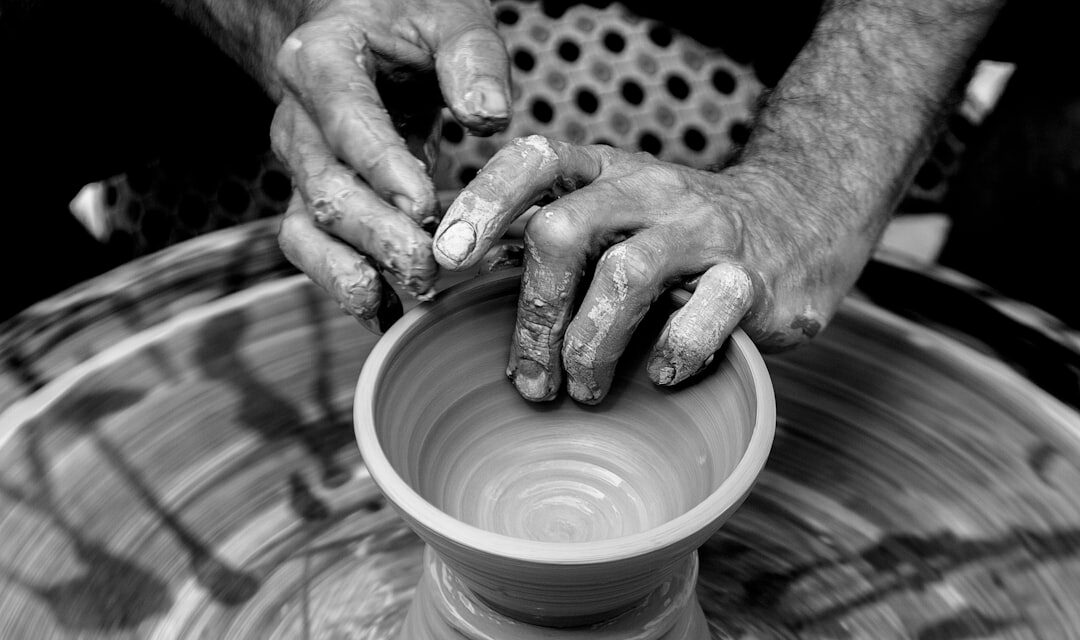The history of ceramic forming is a rich tapestry that weaves together the evolution of human creativity and technological advancement. The origins of ceramics can be traced back to the Upper Paleolithic period, around 29,000 BCE, when early humans began crafting rudimentary clay figurines, such as the famous Venus of Dolní Věstonice. These early creations were not merely artistic expressions; they served practical purposes, such as storage and cooking.
As societies progressed, so too did their techniques and understanding of materials. By the time of the Neolithic Revolution, around 10,000 BCE, pottery became a vital aspect of daily life, with communities developing distinct styles and methods that reflected their cultural identities. The invention of the potter’s wheel in Mesopotamia around 3500 BCE marked a significant turning point in ceramic forming, allowing for greater precision and efficiency in the production of pottery.
As civilisations flourished, so did the art of ceramics. Ancient Egypt, China, and Greece each contributed unique innovations to the field. The Egyptians perfected faience, a glazed non-clay ceramic material, while the Chinese developed high-fired porcelain during the Han Dynasty (206 BCE – 220 CE), which would later become highly sought after in Europe.
The Greeks are renowned for their black-figure and red-figure pottery, which not only served functional purposes but also depicted intricate narratives and mythological scenes. Throughout history, ceramics have been used for both practical and decorative purposes, evolving alongside human culture. The Renaissance period saw a revival of interest in classical techniques, leading to the establishment of renowned pottery centres in Italy and beyond.
This historical journey illustrates how ceramic forming has been an integral part of human expression and technological progress.
Summary
- Ceramic forming has a rich history dating back thousands of years, with evidence of early pottery found in various ancient civilizations.
- Tools and materials for ceramic forming include clay, pottery wheel, hand-building tools, glazes, and kiln for firing the finished pieces.
- Hand-building techniques in ceramic forming involve coiling, pinching, and slab construction to create unique and intricate shapes.
- Wheel-throwing techniques in ceramic forming require skill and precision to shape clay on a rotating wheel, producing symmetrical and uniform pieces.
- Surface decoration and glazing in ceramic forming allow artists to add colour, texture, and patterns to their creations, enhancing the visual appeal of the finished pieces.
Tools and Materials for Ceramic Forming
Understanding the Fundamentals of Ceramic Forming
The tools and materials used in ceramic forming are as diverse as the techniques themselves. At the heart of this craft lies clay, a natural material that is malleable when wet but hardens upon firing. There are various types of clay, each with its unique properties; for instance, earthenware is known for its porous nature and vibrant colours, whilst stoneware is more durable and less porous due to its higher firing temperature.
Types of Clay and Their Characteristics
Porcelain, often regarded as the pinnacle of ceramic materials, is prized for its translucence and strength. The choice of clay significantly influences the final outcome of a piece, making it essential for artists to understand the characteristics of each type.
Tools for Shaping and Finishing Ceramics
In addition to clay, ceramic forming requires a range of tools that facilitate the shaping and finishing processes. Basic hand-building tools include wooden modelling tools, metal ribs for smoothing surfaces, and wire cutters for slicing clay. For wheel-throwing techniques, potters rely on a potter’s wheel, which can be either electric or kick-driven, along with various trimming tools to refine shapes after throwing. Glazing tools such as brushes, sponges, and dipping tongs are also crucial for applying surface finishes.
Exploring Creativity in Ceramic Forming
The interplay between these materials and tools allows artists to explore their creativity while adhering to the fundamental principles of ceramic forming.
Hand-Building Techniques in Ceramic Forming

Hand-building techniques are among the oldest methods of creating ceramic objects and remain popular due to their accessibility and versatility. This approach allows artists to manipulate clay without the need for a potter’s wheel, making it ideal for beginners and those seeking to express their individuality through their work. One common hand-building technique is coiling, where long strands of clay are rolled out and stacked to form walls.
This method not only enables the creation of various shapes but also encourages a tactile connection with the material as artists shape each coil into place. Another technique is slab building, which involves rolling out flat sheets of clay that can be cut and assembled into three-dimensional forms. This method is particularly effective for creating geometric shapes or intricate designs.
Pinching is yet another hand-building technique that offers a direct way to shape clay using one’s fingers. By pinching and manipulating a ball of clay, artists can create small bowls or sculptural forms with unique textures and organic shapes. Hand-building techniques allow for a high degree of personal expression; each piece can reflect the artist’s style and intentions.
Moreover, these methods often result in one-of-a-kind creations that carry the marks of the maker’s hands, adding an element of authenticity that is highly valued in contemporary ceramics. As artists continue to explore hand-building techniques, they push the boundaries of what can be achieved with this ancient craft.
Wheel-Throwing Techniques in Ceramic Forming
Wheel-throwing techniques represent a dynamic aspect of ceramic forming that combines skill with artistry. The potter’s wheel serves as a central tool in this process, allowing artists to create symmetrical forms with precision and speed. The technique begins with centring a lump of clay on the wheel head; this initial step is crucial as it sets the foundation for achieving uniform shapes.
Once centred, potters use their hands and various tools to shape the clay into vessels such as bowls, vases, or mugs. The rhythmic motion of the wheel creates a meditative experience for many potters, allowing them to connect deeply with their craft. One of the key advantages of wheel-throwing is its ability to produce functional ware that is both aesthetically pleasing and practical.
The process allows for intricate designs to be incorporated into the forms while maintaining structural integrity. Potters can create variations in thickness and texture by adjusting their technique during throwing. Additionally, wheel-thrown pieces can be easily altered after they have been shaped; trimming excess clay from the base or adding decorative elements becomes a seamless part of the process.
As potters refine their skills over time, they often develop signature styles that distinguish their work within the broader ceramic community.
Surface Decoration and Glazing in Ceramic Forming
Surface decoration and glazing are essential components of ceramic forming that elevate functional objects into works of art. The application of surface decoration can take many forms, from painting and carving to stamping and slip trailing. Artists often use underglazes or slips—liquid clay mixtures coloured with oxides—to create intricate designs on their pieces before firing them in a kiln.
This pre-firing decoration allows for vibrant colours that can enhance the overall aesthetic appeal of the work. Techniques such as sgraffito involve scratching through a layer of slip to reveal contrasting colours beneath, adding depth and texture to the surface. Glazing is another critical aspect that not only enhances visual appeal but also serves practical purposes such as waterproofing and adding durability to ceramic pieces.
Glazes come in various formulations that can produce different finishes—from glossy to matte—and can be applied through dipping, brushing, or spraying methods. The chemistry behind glazes is complex; factors such as temperature during firing and the composition of materials used can significantly affect the final appearance. Artists often experiment with layering different glazes or incorporating additives like ash or minerals to achieve unique effects.
This exploration of surface decoration and glazing allows ceramists to express their creativity while also engaging with the scientific principles underlying their craft.
Firing and Kiln Techniques in Ceramic Forming

The Firing Process in Ceramics
Firing is a pivotal stage in ceramic forming that transforms raw clay into durable objects through heat treatment. The process typically occurs in a kiln—a specialised oven designed to reach high temperatures necessary for sintering clay particles together. There are various types of kilns used in ceramics, including electric kilns, gas kilns, and wood-fired kilns, each offering distinct firing atmospheres that influence the final outcome of the pieces being fired.
Types of Kilns and Their Effects
For instance, wood-fired kilns create unique surface effects due to ash deposits during combustion, resulting in unpredictable yet beautiful finishes. This is a result of the combustion process, which cannot be replicated in electric or gas kilns.
The Stages of Firing
The firing process itself can be divided into several stages: bisque firing followed by glaze firing. Bisque firing occurs at lower temperatures (around 900-1000°C) to remove moisture from the clay and harden it without vitrifying it completely. This initial firing prepares the piece for glazing by creating a porous surface that allows glazes to adhere effectively.
Glaze Firing and Final Results
After glazing, a second firing takes place at higher temperatures (typically between 1200-1300°C) to melt the glaze materials into a glassy finish while further strengthening the ceramic body. Understanding these firing techniques is crucial for ceramists as they navigate how temperature variations impact colour development and surface texture.
Contemporary Artists and Ceramic Forming
Contemporary ceramic artists are pushing the boundaries of traditional practices while exploring new concepts and materials within ceramic forming. Many artists today blend techniques from various disciplines—such as sculpture, painting, and installation art—to create innovative works that challenge conventional notions of ceramics as merely functional objects. Artists like Grayson Perry have gained international acclaim for their provocative pieces that combine traditional pottery techniques with contemporary themes such as identity and social commentary.
Perry’s work exemplifies how ceramics can serve as a medium for storytelling while engaging audiences on multiple levels. Moreover, contemporary ceramics have seen a resurgence in popularity due to movements such as studio pottery, where individual artisans create unique pieces outside mass production systems. This shift has led to an increased appreciation for handmade ceramics in both domestic settings and galleries worldwide.
Artists like Magdalene Odundo have garnered recognition for their sculptural vessels that draw inspiration from African traditions while incorporating modern aesthetics. As contemporary artists continue to explore new materials—such as 3D printing technology alongside traditional methods—they expand the possibilities within ceramic forming, ensuring its relevance in today’s art world.
Tips for Beginners in Ceramic Forming
For those embarking on their journey into ceramic forming, there are several tips that can help ease the learning curve while fostering creativity. First and foremost, it is essential to familiarise oneself with different types of clay available; experimenting with various clays will provide insight into how each behaves during shaping and firing processes. Beginners should also invest time in mastering basic hand-building techniques before progressing to more complex methods like wheel-throwing; this foundational knowledge will enhance overall skills and confidence.
Additionally, joining a local pottery class or community studio can provide invaluable support through shared experiences with fellow learners and access to professional guidance from experienced instructors. Practising regularly is key; consistency will help develop muscle memory essential for shaping clay effectively over time. Lastly, embracing mistakes as part of the learning process is crucial—each misstep offers an opportunity for growth and experimentation within this dynamic art form.
By approaching ceramic forming with curiosity and patience, beginners can cultivate their unique artistic voice while enjoying the tactile pleasures inherent in working with clay.
For those intrigued by the nuances of ceramic forming and its artistic applications, exploring related art movements and artists can provide a broader understanding of its historical and stylistic context. A particularly relevant exploration can be found in the examination of Baroque art, which is known for its dramatic use of detail and emphasis on movement and tension. To delve deeper into this period and see how its principles might intersect with the techniques of ceramic forming, consider reading An Introduction to Baroque Art. This article offers insights into the characteristics of Baroque art that could inspire ceramic artists in their craft.




